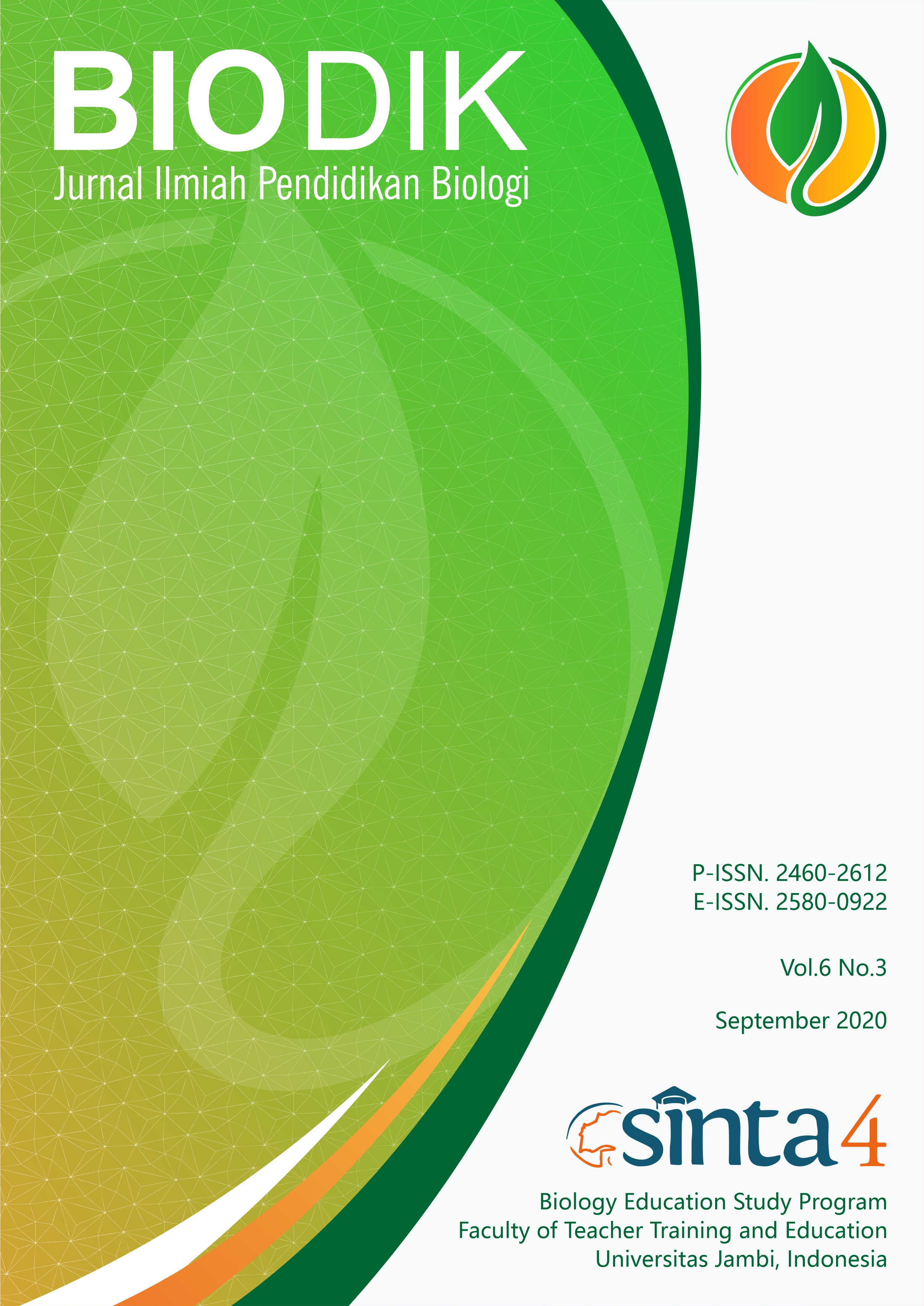Analisis Komponen Penyusun Lembar Kerja Siswa Biologi SMA Pada Praktikum Uji Enzim Katalase
(Analysis of the Students Worksheet Component of Senior High School Biology on Catalase Enzyme Test Practicum)
DOI:
https://doi.org/10.22437/bio.v6i3.9513Abstract
Students Worksheet is a very important guide for doing work in the laboratory which is often used by teachers and students. This study aims to analyze the existence of the constituent components and to provide an overview of the Students Worksheet Catalase Enzyme Test contained in the High School Biology textbooks. The research method used is descriptive qualitative method with a samples of 8 Students Worksheet chosen by using purposive sampling technique. The research instrument used was a LKS analysis instrument, table of work step and rubric test results based on the Vee diagram. The results showed that the Students Worksheet in terms of conceptual analysis as a whole was not in accordance with the applicable curriculum. For practical analysis as a whole it has shown quite good results even though there are still some Students Worksheet whose components are incomplete. Then the analysis of knowledge construction shows that the knowledge construction process has not been developed properly. In addition, from the results of the work step test there are still problems as in the choice of sentence instructions the steps of the work are less precise and less appropriate so that it can confuse students in their execution. In terms of completeness and component scores Students Worksheet based on the Vee Diagram, only a small portion of the catalase enzyme student activity sheet did not have the complete Vee Diagram component. Nevertheless, these components have different qualities which are indicated by the achievement scores of each component of Diagram Vee. Based on these problems, the Catalyst Enzyme Test LKS requires an analysis and improvement in terms of conceptual, procedural, and knowledge construction.
Abstrak. Lembar Kerja Siswa merupakan suatu pedoman yang sangat penting untuk melakukan kerja di laboratorium yang sering digunakan oleh guru dan siswa. Penelitian ini bertujuan untuk menganalisis keberadaan komponen penyusun dan memberikan gambaran tentang Lembar Kerja Siswa Uji Enzim Katalase yang terdapat pada buku paket Biologi SMA. Metode penelitian yang digunakan adalah metode deskriptif kualitatif dengan sampel penelitian berjumlah 8 LKS yang dipilih dengan menggunakan teknik purposive sampling. Instrumen penelitian yang digunakan adalah berupa instrument analisis LKS, tabel hasil uji langkah kerja dan rubrik berdasarkan diagram Vee. Hasil penelitian menunjukkan bahwa Lembar Kerja Siswa tersebut dari segi analisis konseptual secara keseluruhan kurang sesuai dengan kurikulum yang berlaku. Untuk analisis praktikal secara keseluruhan sudah menunjukkan hasil yang lumayan baik walaupun masih terdapat beberapa LKS yang komponennya belum lengkap. Kemudian analisis konstruksi pengetahuan menunjukkan bahwa proses konstruksi pengetahuan belum terbangun dengan baik. Selain itu, dari hasil uji langkah kerja masih terdapat permasalahan seperti dalam pemilihan kalimat instruksi langkah kerja yang kurang tepat dan kurang sesuai sehingga dapat membingungkan siswa dalam eksekusinya. Dari segi kelengkapan dan skor komponen LKS berdasarkan Diagram Vee, hanya sebagian kecil LKS enzim katalase yang tidak memiliki komponen Diagram Vee lengkap. Meskipun demikian, komponen-komponen tersebut memiliki perbedaan kualitas yang ditunjukkan oleh capaian skor dari masing-masing komponen Diagram Vee. Berdasarkan permasalahn tersebut, maka LKS Uji Enzim Katalase memerlukan sebuah analisis dan perbaikan dari segi konseptual, prosedural, maupun konstruksi pengetahuan.
Downloads
References
Baedowi, Ahmad. (2015). Manajemen Sekolah Efektif: Pengalaman Sekolah Sukma Bangsa. Jakarta: Pustaka Alvabet.
Djamarah, S. B dan Aswan Zain. (2006). Strategi Belajar Mengajar. Jakarta: PT Rineka Cipta.
Kruea-In Chatchai, Nantarat Kruea-In, and Witat Fakcharoenpholb. (2015). A Study of Thai In-Service and Pre-Service Science Teachers’ Understanding of Science Process Skills. Procedia - Social and Behavioral Sciences 197, 993 – 997.
Laelasari, Iseu dan Bambang Supriatno. (2018). Analisis Komponen Penyusun Desain Kegiatan Laboratorium Bioteknologi. Jurnal Bioedukatika. 6(2), 84 – 90.
Millar, R., & Abrahams, I. (2009). Practical Work: Making It More Effective. School Science Review, 59-64.
Millar, R. (2004). The Role of Practical Work in The Teaching and Learning of Science. Washington DC. National Academy of Sciences.
Rini, Annisa Setya. (2013). Analisis Relevansi Desain Kegiatan Laboratorium Terhadap Kompetensi Dasar dalam Konsep Protista. Skripsi Jurusan Pendidikan Biologi FPMIPA UPI: Tidak diterbitkan.
Supriatno, B. (2009). Uji Langkah Kerja Laboratorium Sekolah. Proseding Seminar Nasional Biologi: Inovasi dan Pendidikan Biologi dalam Pengembangan Sumber Daya Manusia, 255-261.
Supriatno, B. (2013). Pengembangan Program Perkuliahan Pengembangan Praktikum Biologi Sekolah Berbasis ANCORB untuk Mengembangkan Kemampuan Merancang dan Mengembangkan Desain Kegiatan Laboratorium. Disertasi Jurusan Pendidikan Biologi FPMIPA UPI: Tidak diterbitkan.
Swami & Shields. (2006). Gowin’s Knowledge Vee: Using To Improve Preservice Teachers Ability for Conducting and Directing Science. University of Cincinnati.
Wahidah, Nur Sopiah, Bambang Supriatno, dan Mimin Nurjhani Kusumastuti. (2018). Analisis Struktur dan Kemunculan Tingkat Kognitif pada Desain Kegiatan Laboratorium Materi Fotosintesis. Assimilation: Indonesian Journal of Biology Education, 1(2), 70-76.
Downloads
Published
Versions
- 2020-10-07 (3)
- 2020-10-07 (2)
- 2020-09-05 (1)
How to Cite
Issue
Section
License
Copyright (c) 2020 Devi Deratama, Sri Anggraeni, Bambang Supriatno

This work is licensed under a Creative Commons Attribution-NonCommercial-ShareAlike 4.0 International License.
Copyright Notice
Authors who publish with Biodik : Jurnal Ilmiah Pendidikan Biologi agree to the following terms:
- For all articles published in Biodik : Jurnal Ilmiah Pendidikan Biologi, copyright is retained by the authors and grant the journal right of first publication with the work simultaneously licensed under a Creative Commons Attribution-ShareAlike 4.0 International Licensethat allows others to share the work with an acknowledgment of the work's authorship and initial publication in this journal.
- Authors are able to enter into separate, additional contractual arrangements for the non-exclusive distribution of the journal's published version of the work (e.g., post it to an institutional repository or publish it in a book), with an acknowledgment of its initial publication in this journal.
- Authors are permitted and encouraged to post their work online (e.g., in institutional repositories or on their website) prior to and during the submission process, as it can lead to productive exchanges, as well as earlier and greater citation of published work (See The Effect of Open Access).
















